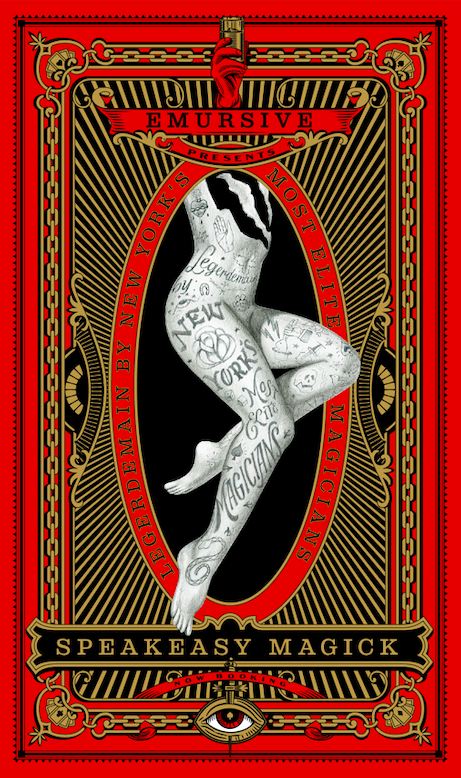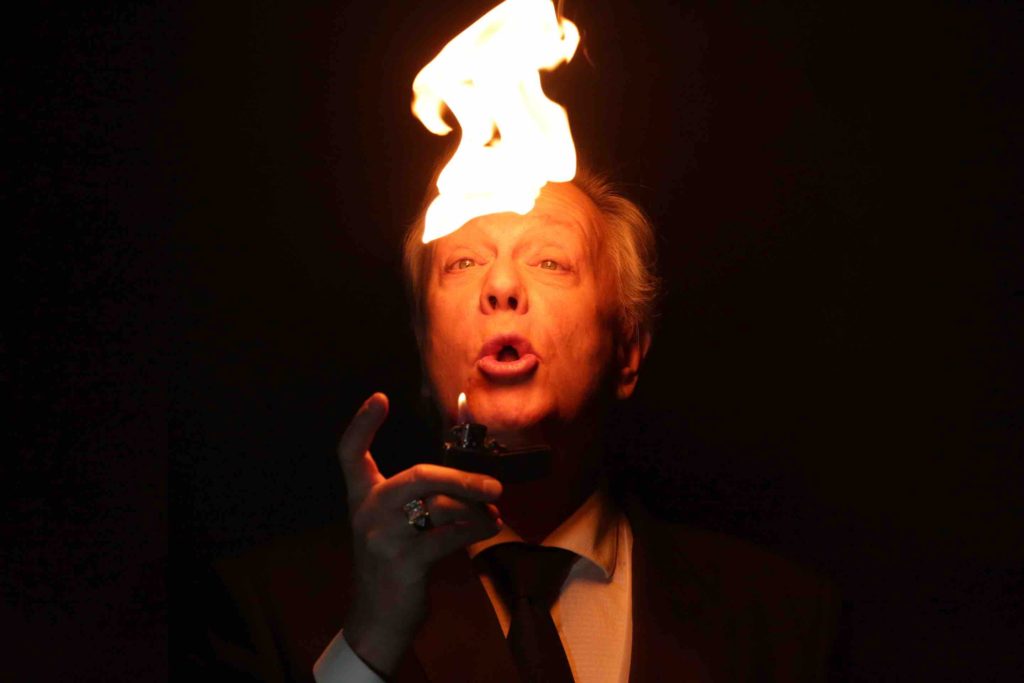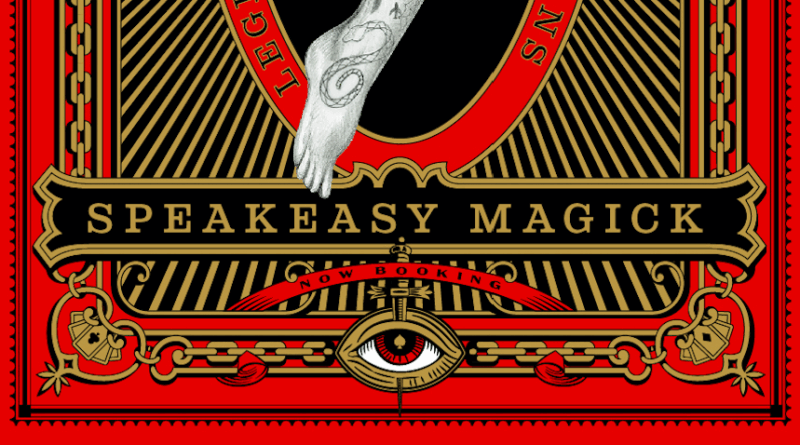INTERVIEW: In Manhattan, there’s a speakeasy where ‘Magick’ happens every night
Image courtesy of Speakeasy Magick / Provided by DKC O&M with permission.
NEW YORK — There have been a lot of changes at Emursive, the immersive theater company in New York City. The long-running Sleep No More is sleeping no more in the Big Apple, and Life and Trust shuttered a few weeks ago. Still, there’s a well-established and celebrated gem amongst the company’s offerings, and that’s Speakeasy Magick, an illusion show that is best kept a secret for maximum audience impact.
The only details this writer is able to share is that theatergoers are whisked away to another world where sleight-of-hand is the rule of the day, where coins appear out of nowhere and everyone’s sleeves are being inspected. Drinks run aplenty, and there’s a smoky ambiance that pervades the proceedings. It’s not hard to imagine oneself as a time traveler, headed back to the Prohibition era when libations ventured underground and magick had an extra “k.”
Welcome to Speakeasy Magick.
One of the performers at the illusionist variety show is Jeff Kellogg, who recently told Hollywood Soapbox that is has been a dream performing in the show. He remembers how he landed the gig as if it were yesterday; it was due to a chance encounter with the host of Speakeasy Magick, Todd Robbins.
“I was a cocktail bartender for about 10 years in New York City around various cocktail bars, and the very last place that I worked was a place called The Rub House in Times Square,” Kellogg said in a recent phone interview. “One day Todd Robbins, who hosts the show, came in with one of the mind readers to discuss the show. … His name was Jason, and he said, ‘You should hire Jeff. He’s known as a really good coin magician.’ That’s sort of my specialty, and Todd went, ‘Oh yeah, he’s on the list.’ Todd knew me from here and there. The magic community is quite small.”
That encounter kept Kellogg’s name in Robbins’ mind, and then after Speakeasy started to find success and more magicians were needed, he received the call to perform one night. The problem was that he was still bartending and needed to figure out this crossroads in his career.
“I said to myself, ‘Anytime they call me, I’ll get someone else to fill in at the bar, and even if I can’t find someone to fill in, I’ll just say I can’t go to work because I’m sick.’ I made it a priority,” he said. “And it got to a point where they just said, ‘We can’t do this anymore at the bar,’ because I was calling out day of because I was getting called in day of at Speakeasy, so that was my transition to the show. … I was never a full-time magician before this, and I just got thrown into it, which was really neat.”
Kellogg immediately fell in love with the format of the multi-hour evening, where patrons sit at intimate tables and have illusionists come and go as the evening proceeds. The magic at Speakeasy is closeup, within a few inches of the ticket buyers. There’s no hiding, yet somehow secretive techniques remain hidden.
“When I entered the show, it was quite apparent how special it was with the variety of magicians that you get to see,” Kellogg said. “The atmosphere, the way that they have you whisked away, they really do care about that when you enter the room. You’re in a different place, and that’s sort of what attracted me to magic. When you see magic, you forget where you are for a bit.”
Kellogg’s entry to the world of illusions is a little different when compared to other performers and their origin stories. He grew up in a small town, and at a young age a few people started dabbling in magic. He remembers four of his friends trying to master a variety of tricks, and they were passionate about their emerging craft.
“One of them is my best friend to this day,” he said. “I was the best man at his wedding, and he does the show as well. His name is Noah Levine, and I credit him with getting me seriously into magic. Most young magicians get a book or a magic set or see someone do it and try a little bit of it here and there, and I did that, too. But I saw Noah Levine, who is an exceptional magician. I saw him in middle school around a lunch table in the cafeteria. He was kind of the quiet kid. I had known him for years, but I saw him around this table surrounded by people. And I didn’t know what was going on. I elbowed my way through, and I saw him making objects disappear and reappear, change color, move from one place to another. At one point, he took a fork and put it on the table and took a napkin and placed it over the fork. Then the fork levitated into the air completely surrounded by everyone, and he whisked the cloth away, and the fork just vanished in mid-air. And then the bell rang. Lunch was over, and I realized, oh, I’m at school. I was whisked away. I realized at that point that I had to look into this.”
Kellogg went up to Levine at that point and asked him whether he could learn some of the acts. Levine apparently brushed him off; that is, until the next day when Kellogg came with his own trick and offered to trade knowledge with his hopeful new friend.
“And we’ve just been going back and forth learning from each other ever since,” Kellogg said. “It is kind of like a ladder. If I meet a new magician at a convention or a bar, or if he’s a friend of another magician, he’ll show me a trick, and I’ll show him something. And if you’re really interested in a trick that the guy does, and you don’t know how to do it or you want to learn more about it, you’re going to have to show something that’s equal to that step on the ladder, to show him that you know what you’re talking about.”
As an example of this magical trade, Kellogg used David Copperfield in a hypothetical example. If someone walks up to the famous magician and asks how he made the Statue of Liberty disappear, probably the trick will remain hidden. If that performer comes back with the ability to disappear the Empire State Building, then maybe a conversation will ensue.
“It’s like that: rungs of the ladder, just stepping up,” he said. “It’s kind of cool, if you go to a convention, when you first meet a new magician, you can show him, ‘This is my version of this classic.’ Then he’ll go, ‘Oh, here’s my version’. You go, ‘Oh wow. That’s really cool, and I have this other thing with this other step.’ You just keep stepping up until you meet on that rung where you both are. Because it’s based in secrets, there’s not really anything you can compare it to, possibly pool or other sports where there are tricks and tips about how to do something. It is definitely community-based. You’ll find stuff in books, but you won’t know the real stuff unless you talk to other magicians.”
And that’s what Kellogg does every night he’s appearing in Speakeasy Magick. He’s performing for the sold-out crowds, but he’s also trading stories and techniques with his fellow illusionists in a tucked-away watering hole at an undisclosed location.
By John Soltes / Publisher / John@HollywoodSoapbox.com
Speakeasy Magick, featuring Jeff Kellogg, continues in Downtown Manhattan. Click here for more information and tickets.



